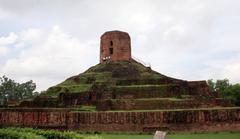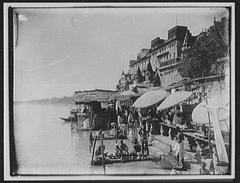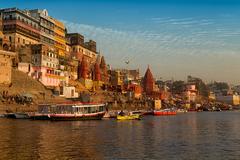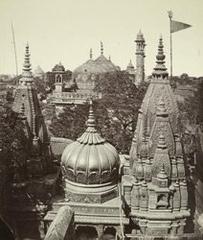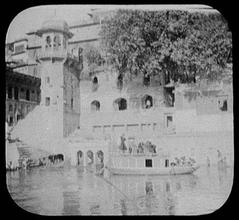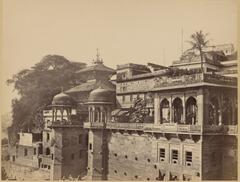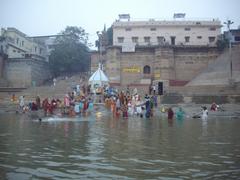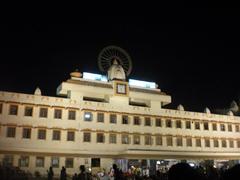
The Ultimate Guide to Exploring Varanasi, Varanasi District, India
When to Visit: 30/07/2024
Welcome to Varanasi: A City of Eternal Charm
Imagine stepping into a living, breathing tapestry of history, where the whispers of ancient chants blend seamlessly with the hustle of modern life. Welcome to Varanasi, the spiritual heartbeat of India and one of the oldest continually inhabited cities on the planet. Here, time stands still as you traverse the sacred ghats along the Ganges, feel the vibrations of centuries-old aartis, and lose yourself in the labyrinthine alleys that have witnessed millennia of human existence (Varanasipedia).
Varanasi, also known as Kashi or Benares, has a history that stretches back to around 2000 BCE, making it older than even the pyramids of Egypt. It’s a city where legends come alive—believed to be founded by Lord Shiva himself, it’s a melting pot of Hindu, Buddhist, and Jain traditions (Indian Culture). Picture the scene: bustling marketplaces from the Vedic era, the serene face of Buddha as he delivered his first sermon in nearby Sarnath, and the cultural renaissance under Mughal Emperor Akbar.
But Varanasi isn’t just about its storied past. It’s a city that seamlessly blends tradition with modernity. From the educational excellence of Banaras Hindu University (BHU) to the vibrant street food culture, Varanasi is a city of contrasts and surprises. As you walk along the ghats, you’ll witness age-old rituals juxtaposed with the digital age—Instagramming monks, anyone? (The Hosteller).
Ready to dive into the mystical allure of Varanasi? Get ready for a journey through time, spirituality, and culture. Whether you’re a seeker of enlightenment, a history buff, or simply an adventurer, Varanasi promises an experience like no other. And to unlock the city’s secrets, download Audiala, your ultimate travel companion, and let the magic of Varanasi unfold before you.
Journey Map
- Historical Background
- Dive into Varanasi: Where Time Stands Still
- Ancient Origins and Vedic Era (2000 BCE – 500 BCE)
- The Rise of Buddhism (500 BCE – 300 BCE)
- Gupta Period and Medieval Era (300 CE – 1200 CE)
- Islamic Influence and Mughal Period (1200 CE – 1757 CE)
- British Rule and the Revival of the City (1757 CE – 1947 CE)
- Post-Independence Era (1947 CE – Present Day)
- Cultural and Religious Significance
- Temples and Ghats
- Educational and Cultural Institutions
- Modern Developments
- Conclusion
- Cultural and Spiritual Significance of Varanasi
- Embark on a Spiritual Odyssey in Varanasi
- Unveiling History
- The Spiritual Pulse
- Ghats: The Soul of Varanasi
- Rituals and Festivals: A Kaleidoscope of Devotion
- A Cultural Tapestry
- Beyond Hinduism: Buddhist and Jain Influences
- Insider Tips for Your Journey
- Local Lingo Lessons
- FAQ Section
- Interactive Elements: Challenges and Mini-Quests
- Day Trips for the Curious Soul
- Key Attractions
- A Journey Through Varanasi’s Timeless Charm
- Ghats of Varanasi
- Dashashwamedh Ghat
- Manikarnika Ghat
- Assi Ghat
- Temples of Varanasi
- Kashi Vishwanath Temple
- Sankat Mochan Hanuman Temple
- Durga Temple
- Cultural and Historical Sites
- Sarnath
- Bharat Kala Bhavan Museum
- Festivals and Events
- Dev Deepawali
- Holi
- Local Cuisine
- Street Food
- Sweets
- Practical Tips for Visitors
- Best Time to Visit
- Safety Tips
- Respect Local Customs
Historical Background
Dive into Varanasi: Where Time Stands Still
Picture this: a city where the air is thick with centuries-old chants, where the Ganges River whispers secrets of ancient civilizations, and where every corner tells a tale. Welcome to Varanasi, one of the oldest living cities on Earth, a place that has seen it all and still stands tall.
Ancient Origins and Vedic Era (2000 BCE – 500 BCE)
Before the pyramids were built, there was Varanasi. Known as Kashi or Benares, this city dates back to around 2000 BCE. Imagine bustling markets with traders exchanging everything from spices to silks, all under the watchful eye of Lord Shiva, who, according to myth, founded the city himself. The Ramayana and the Mahabharata, some of Hinduism’s most revered texts, were penned here. Talk about a city with literary cred! (Varanasipedia)
The Rise of Buddhism (500 BCE – 300 BCE)
Fast forward to 500 BCE, and enter Lord Buddha, who chose nearby Sarnath to deliver his first sermon. The Dhamek Stupa stands as a testament to this pivotal moment in Buddhist history. Imagine the serene atmosphere, the rustle of robes, and the profound silence that must have marked this spiritual milestone. (Learn Religions)
Gupta Period and Medieval Era (300 CE – 1200 CE)
The Gupta period saw Varanasi thriving as a cultural epicenter. Think of a city teeming with artisans crafting muslin, silk, perfumes, and ivory works. Xuanzang, the Chinese Buddhist pilgrim, described it as a city stretching 5 kilometers along the Ganges’ western bank. If only Instagram had been around! (Britannica)
Islamic Influence and Mughal Period (1200 CE – 1757 CE)
The medieval period brought Islamic influence, which layered Varanasi with new architectural marvels and cultural amalgamations. Despite invasions, the city’s spirit remained unbroken. Under Mughal Emperor Akbar, a renaissance of sorts occurred, allowing Varanasi to regain its stature as a cultural and educational hub. (Varanasipedia)
British Rule and the Revival of the City (1757 CE – 1947 CE)
Enter the British East India Company in 1757, and Varanasi transformed into a bustling trade center. Educational institutions like Banaras Hindu University (BHU) sprouted, fostering a new generation of thinkers and freedom fighters. Imagine the fervor and the whispers of revolution in the air. (Varanasipedia)
Post-Independence Era (1947 CE – Present Day)
Post-1947, Varanasi became a proud part of Uttar Pradesh, blending modernity with tradition. Skyscrapers and ancient temples coexist, and the city buzzes with life, drawing millions of visitors each year. (Varanasipedia)
Cultural and Religious Significance
In Varanasi, spirituality is a way of life. It’s believed that Lord Shiva himself made this city his home, and a dip in the Ganges can wash away a lifetime of sins. Can you feel the divine vibes already? (Indian Culture)
Varanasi is also a cornerstone for Buddhism and Jainism. Sarnath is where Buddha preached, and Jain temples are scattered throughout the city. (Indian Culture)
Temples and Ghats
Varanasi is a temple town like no other. The Kashi Vishwanath Temple, dedicated to Lord Shiva, is a spiritual hotspot. Then there’s the Bharat Mata Temple, celebrating the motherland, and the Sankat Mochan Hanuman Temple, a haven for Hanuman devotees. Picture the mesmerizing aartis and yagnas, the air filled with incense and devotion. (Indian Culture)
The ghats of Varanasi are where the magic happens. With around 100 ghats, each one tells a story. Take a stroll down Dashashwamedh Ghat or Manikarnika Ghat, and let the sacred Ganges wash over your senses. (From Here to India)
Educational and Cultural Institutions
Banaras Hindu University (BHU) is the academic pride of Varanasi, renowned for its rich heritage and stunning architecture. Wander through its sprawling campus, take a guided tour, or catch a cultural show. (From Here to India)
Modern Developments
While Varanasi embraces modernity with upgraded infrastructure, it retains its ancient charm. It’s a city where the past and the present dance together in perfect harmony. (Varanasipedia)
Conclusion
Varanasi is more than a city; it’s an experience. Whether you’re seeking spiritual enlightenment or a vibrant cultural journey, Varanasi beckons with open arms. Ready to explore? Download the Audiala app and let Varanasi’s magic unfold before you.
Cultural and Spiritual Significance of Varanasi
Embark on a Spiritual Odyssey in Varanasi
Imagine stepping into a city where every corner whispers ancient tales, where the air is thick with incense and the sound of temple bells. Welcome to Varanasi, or as the locals fondly call it, Kashi—a city that promises to stir your soul.
Unveiling History
Varanasi isn’t just a dot on a map; it’s a living, breathing testament to time itself. Over 3,000 years of continuous habitation make it one of the world’s oldest cities. Nestled along the northern banks of the sacred Ganges, where the Varuna and Assi rivers meet, Varanasi’s name is a gift from its geography. Legend has it that Lord Shiva himself founded this city, marking it as a spiritual epicenter for Hindus (Indian Culture).
The Spiritual Pulse
Regarded as the spiritual heart of India, Varanasi is where seekers come to cleanse their sins and find enlightenment. A dip in the Ganges River is said to purify the soul. The city is dotted with temples, each narrating stories of devotion. The Kashi Vishwanath Temple, dedicated to Lord Shiva, stands as the crown jewel (Banaras Trip). Don’t miss the Bharat Mata Temple or the Sankat Mochan Hanuman Temple, each a chapter in Varanasi’s spiritual saga (Indian Culture).
Ghats: The Soul of Varanasi
Imagine walking down steps that lead to the Ganges, where pilgrims perform rituals and seek solace. That’s what the ghats of Varanasi offer. With over 80 ghats, each one has its own story. Manikarnika and Harishchandra ghats are particularly poignant, where Hindus believe that cremation on the Ganges’ banks grants moksha, or liberation from the cycle of life and death (Laure Wanders).
Rituals and Festivals: A Kaleidoscope of Devotion
Get ready to be enchanted by the Ganga Aarti at Dashashwamedh Ghat, a symphony of chants, fire, and synchronized movements that will leave you spellbound (Banaras Trip). Varanasi pulses with festivals; experience the glow of Dev Deepavali in November or immerse yourself in the riot of colors during Holi (Laure Wanders).
A Cultural Tapestry
Varanasi isn’t just about spirituality; it’s a cultural haven. Discover the city’s classical music and dance, marvel at the intricate Banarasi sarees, and lose yourself in the rich literary collections of Hindi and Sanskrit. Banaras Hindu University (BHU) is a cornerstone of academic and cultural life here (The Hosteller).
Beyond Hinduism: Buddhist and Jain Influences
Varanasi also holds a special place in Buddhism and Jainism. Just a short trip away, Sarnath is where Lord Buddha delivered his first sermon, making it a pivotal Buddhist pilgrimage site. Jain temples and shrines also dot the city, adding layers to its spiritual fabric (Indian Culture).
Insider Tips for Your Journey
Best Time to Visit: October to March is ideal for a visit, with pleasant weather and the added charm of festival season in October and November (The Hosteller).
What to Wear: Modesty is key. Cover your legs and shoulders when visiting temples and ghats to respect local customs. Leave those shorts and sleeveless tops at home (The Hosteller).
Safety First: While Varanasi is generally safe, stay vigilant, avoid isolated areas after dark, and keep your belongings secure (The Hosteller).
Taste the City: From tamatar chaat to Banarasi kebabs, Varanasi’s culinary scene is a feast for the senses. Try local eateries like Deena Chaat Bhandaar for vegetarian delights and Kebab Bazar for non-vegetarian treats (Banaras Trip).
Shop Like a Local: Wander through the Galis, or narrow lanes, to find silk sarees and traditional handicrafts. Vishwanath Gali and Chowk are must-visit spots for souvenirs (Banaras Trip).
Local Lingo Lessons
To truly immerse yourself, learn a few local phrases:
- Namaste (nah-ma-stay): A common greeting meaning ‘hello’.
- Dhanyavaad (dhuh-nya-vaad): ‘Thank you’.
- Kitne ka hai? (kit-nay kah hai): ‘How much is this?’ Useful for shopping.
- Aap kaise hain? (aap kai-say hain): ‘How are you?’ These phrases will not only help you navigate the city but also endear you to the locals.
FAQ Section
Q: What is the best time to visit Varanasi? A: The best time to visit is from October to March when the weather is pleasant, and festivals are in full swing.
Q: Is Varanasi safe for solo travelers? A: Yes, Varanasi is generally safe, but it’s advisable to stay vigilant, avoid isolated areas after dark, and keep your belongings secure.
Q: What should I wear when visiting temples and ghats? A: Modesty is important. Ensure to cover your legs and shoulders to respect local customs.
Q: Are there any local dishes I must try? A: Absolutely! Don’t miss tamatar chaat, Banarasi kebabs, and sweets like kachori and jalebi.
Q: Can I take photos everywhere? A: While most places allow photography, always ask for permission before taking pictures, especially in temples and during rituals.
Interactive Elements: Challenges and Mini-Quests
- Challenge 1: Find the oldest temple in Varanasi, believed to be the Kashi Vishwanath Temple. Share your experience and any interesting stories you learn with fellow travelers.
- Challenge 2: Attend a Ganga Aarti ceremony at Dashashwamedh Ghat and capture the mesmerizing moments. Post your pictures on social media with the hashtag #VaranasiAarti.
- Challenge 3: Explore the narrow lanes and find a local artisan making Banarasi sarees. Learn about the craft and share your newfound knowledge with others.
Day Trips for the Curious Soul
Sarnath: Just 10 km away, visit the place where Buddha gave his first sermon. The Sarnath Archaeological Site is a treasure trove of ancient stupas, temples, and statues (Laure Wanders).
Nearby Cities: Explore Prayagraj, Ayodhya, and Jaunpur for more cultural and historical insights (The Hosteller).
Key Attractions in Varanasi
A Journey Through Varanasi’s Timeless Charm
Welcome to Varanasi, the beating heart of India’s spiritual soul. With every sunrise, the city awakens in a symphony of bells, chants, and the rustling of the sacred Ganges. Ready to dive into the mystical allure of this ancient city? Let’s embark on a journey like no other!
Ghats of Varanasi
Varanasi’s ghats are the lifeblood of the city, where time seems to stand still. Picture yourself stepping onto these riverfront steps, immersing into a world brimming with rituals, history, and vibrant local life. With over 80 ghats, each one is a gateway to a unique story.
Dashashwamedh Ghat
Imagine the air thick with incense, the rhythmic chants resonating in your ears, and the mesmerizing dance of flames during the Ganga Aarti. Dashashwamedh Ghat, created by Lord Brahma himself, is the epitome of divine energy. Don’t just visit; participate and lose yourself in this enchanting ritual (Meander Wander).
Manikarnika Ghat
Ever wondered about the cycle of life and death? Manikarnika Ghat is not just a place, but a profound experience. As you watch the eternal cremation fires, you gain a deeper understanding of moksha and the Hindu belief in liberation from rebirth (Classy Nomad).
Assi Ghat
At the confluence of the Ganges and Assi rivers lies a haven of tranquility. Start your day with a refreshing yoga session at Assi Ghat, and as the dawn breaks, feel the first rays of the sun kiss the river. It’s a serene escape from the city’s hustle and bustle (Book Retreats).
Temples of Varanasi
Varanasi is a canvas painted with the hues of divinity and history. Each temple is a stroke of spiritual significance.
Kashi Vishwanath Temple
With its gold-plated spire gleaming under the sun, the Kashi Vishwanath Temple is a sight to behold. Dedicated to Lord Shiva, this temple is one of the twelve Jyotirlingas. Dip into the Ganges and feel the purity wash over your soul (Varanasipedia).
Sankat Mochan Hanuman Temple
Seek solace at the Sankat Mochan Hanuman Temple, founded by the poet-saint Tulsidas. Amidst the serene ambiance, let your worries melt away. Don’t miss the annual music and dance festival that breathes life into the temple (Jovial Holiday).
Durga Temple
Also known as the Monkey Temple, Durga Temple is an architectural marvel. The idol of Goddess Durga is believed to have miraculously appeared. Watch out for the playful monkeys that add a whimsical charm to your visit (Classy Nomad).
Cultural and Historical Sites
Beyond the spirituality, Varanasi is a treasure trove of culture and history waiting to be explored.
Sarnath
A short trip to Sarnath, where Lord Buddha delivered his first sermon, is a must. Explore the Dhamek Stupa, Ashoka Pillar, and the rich collection of Buddhist artifacts at the Sarnath Archaeological Museum (Encounterstravel).
Bharat Kala Bhavan Museum
Nestled in the Banaras Hindu University, the Bharat Kala Bhavan Museum is a cultural gem. From miniature paintings to ancient sculptures, every artifact narrates a piece of India’s rich heritage (Book Retreats).
Festivals and Events
Varanasi’s festivals are a riot of colors, sounds, and emotions. Dive into the celebrations and become part of the city’s vibrant tapestry.
Dev Deepawali
Watch the ghats transform into a celestial wonderland during Dev Deepawali. Thousands of diyas light up the riverbanks, celebrating Lord Shiva’s victory. It’s a visual feast you can’t afford to miss (Varanasipedia).
Holi
Join the locals in the exuberant celebration of Holi. As you get drenched in colors, dance to the beats of traditional music, and savor the festive sweets, you’ll feel the essence of Varanasi’s joyous spirit (Classy Nomad).
Local Cuisine
Embark on a culinary adventure in Varanasi, where every dish tells a story.
Street Food
Relish the spicy ‘Kachori Sabzi’ and the tangy ‘Tamatar Chaat’ as you navigate through the bustling streets. Each bite is a burst of flavors that will leave you craving for more (Book Retreats).
Sweets
Indulge in ‘Malaiyo,’ a frothy saffron-flavored dessert that melts in your mouth, and savor the iconic ‘Banarasi Paan.’ These sweet treats are the perfect end to your culinary journey (Meander Wander).
Practical Tips for Visitors
Best Time to Visit
October to March is the ideal time to explore Varanasi. The pleasant weather makes it perfect for sightseeing and soaking in the city’s charm (Book Retreats).
Safety Tips
While Varanasi is generally safe, stay vigilant in crowded areas and avoid isolated places at night. Female travelers should dress modestly and stay aware of their surroundings (Classy Nomad).
Respect Local Customs
Embrace the local customs and traditions. Seek permission before photographing people, especially during religious ceremonies. Your respect will enrich your experience (Book Retreats).
Ready to explore Varanasi? Download Audiala, your ultimate tour guide app, and unlock the city’s secrets and stories. With Audiala, dive deep into expert insights and hidden gems that make Varanasi truly magical. Start your journey today and let Audiala be your guide to unforgettable experiences.
Your Varanasi Adventure Awaits
As you reach the end of this comprehensive guide, it’s clear that Varanasi is more than just a destination—it’s an experience that stays with you long after you’ve left its sacred shores. From the ancient temples and ghats to the vibrant festivals and rich culinary traditions, Varanasi offers a sensory feast that captivates the soul (Banaras Trip).
The city’s unique charm lies in its ability to blend the old with the new. Imagine yourself sipping chai at a riverside café, watching the sunrise over the Ganges, while listening to the distant sound of temple bells and morning prayers. This is Varanasi—a place where every moment feels like a ritual, and every ritual feels like a timeless moment (Laure Wanders).
Whether you’re exploring the narrow lanes filled with silk sarees and handicrafts, participating in the mesmerizing Ganga Aarti at Dashashwamedh Ghat, or taking a day trip to the historical site of Sarnath, Varanasi never ceases to amaze. It’s a city that invites you to slow down, absorb, and reflect (Varanasipedia).
So, are you ready to embark on this unforgettable journey? Download Audiala, your ultimate travel guide app, and let Varanasi’s secrets and stories unfold at your fingertips. With expert insights and hidden gems, Audiala ensures that your exploration of Varanasi is as enriching as it is enlightening. Dive deep into the heart of India’s spiritual capital and let the magic of Varanasi transform you.
Sources and Inspirations
- Varanasi Through the Ages: A Historical Timeline of the City’s Evolution, n.d., Varanasipedia source url
- Brief History of Varanasi (Banaras), n.d., Learn Religions source url
- Varanasi, n.d., Britannica source url
- Varanasi: The Spiritual Heart of India, n.d., Indian Culture source url
- Best Places to Visit in Varanasi, n.d., From Here to India source url
- Varanasi Itinerary for 5 Days, n.d., Banaras Trip source url
- Is Varanasi Worth Visiting?, n.d., Laure Wanders source url
- Ultimate Travel Guide to Varanasi, n.d., The Hosteller source url
- Varanasi Travel Guide, n.d., Meander Wander source url
- Varanasi Travel Guide, n.d., Classy Nomad source url
- Varanasi Travel Guide, n.d., Book Retreats source url
- Exploring the Rich Culture and Heritage of Varanasi, n.d., Varanasipedia source url
- Varanasi: A Comprehensive Travel Guide, n.d., Jovial Holiday source url
- Varanasi Travel Guide, n.d., Encounter Stravel source url


